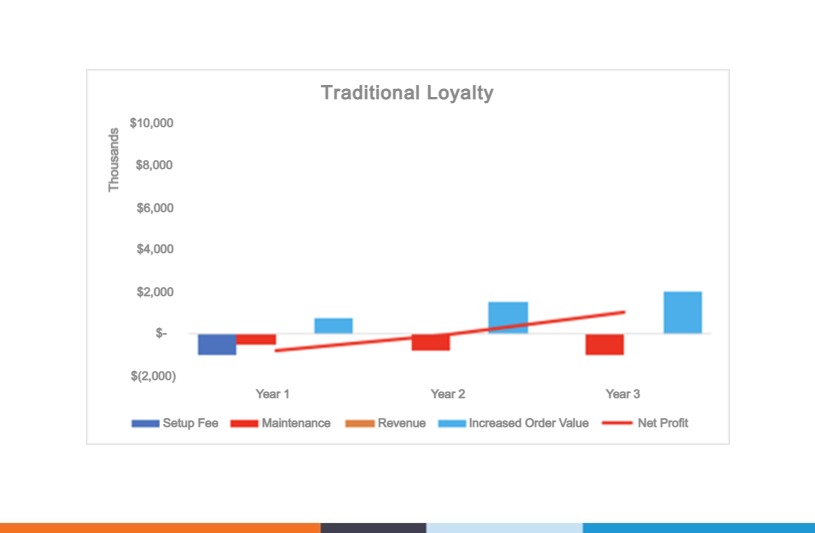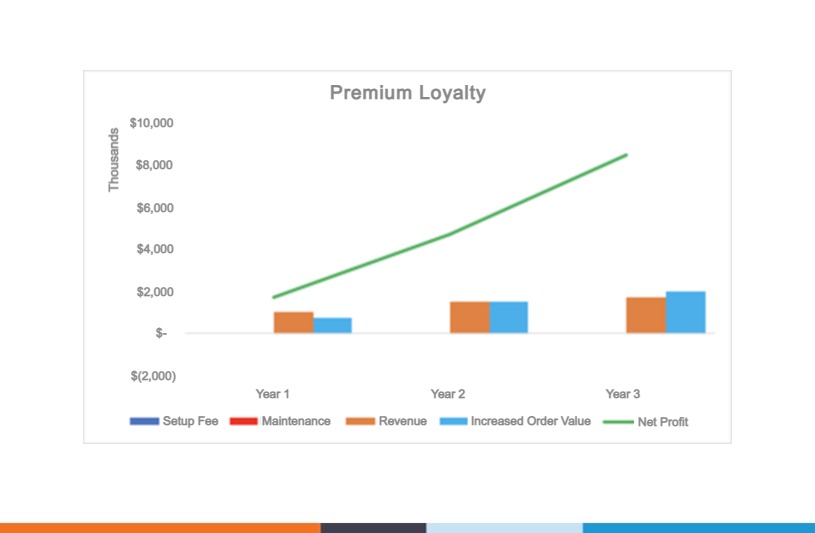This article is part of our Ultimate Guide to Loyalty Programs.
More than 71% of companies invest 2%-4% of their total revenue on customer loyalty and CRM to engage customers, gather data, and deepen relationships with their best customers.
The purpose of investing in loyalty programs is to strengthen your customer relationships, gather key insights, and grow revenue.
Loyalty terms like acquisition, retention, and usage are very important.
If you don’t understand program ROI, you can’t understand what’s working and what’s not and that means you can’t make the smart decisions to keep your business growing.
Core Metrics to Measure Your Loyalty Program ROI
Loyalty program ROI is determined by the incremental behaviors generated because of a customer being a member of your program.
Knowing what these core metrics are and measuring them accurately is critical to your program’s success.
As Lord Kelvin said, “…when you can measure what you are speaking about, and express it in numbers, you know something about it; but when you cannot measure it, when you cannot express it is numbers, your knowledge is of a meagre and unsatisfactory kind.”
Establishing baseline behaviors prior to program vs. behaviors after program enrollment provides you with a baseline to measure your program’s impact.
Incrementality and the financial benefit of members vs. non-members are also crucial to measuring your loyalty program ROI. In this metric, you measure incremental sales of members vs. non-members to assess your program’s impact on both segments.
While members vs. non-members is an example of a baseline metric, you should also closely monitor AOV, member enrollment, engagement rate, amount of active and inactive members, amount of offers redeemed, current member attributed revenue, frequency of purchase, and customer lifetime value.
These comprise your key baseline metrics to measure loyalty program effectiveness.
Other Loyalty Metrics You Should Consider
While the previously mentioned are the main baseline metrics to quantitatively measure your loyalty program ROI, there are other intangible metrics that are equally important.
Measuring consumer brand affinity is challenging, but it tells you the level of emotional attachment and how ingrained your company’s values are to the consumers you covet.
It provides information about how often your brand plays a role in their daily lives when they’re not making a purchase. It also tells you how likely they are to recommend your brand to family and friends.
The best and most direct way to measure brand affinity is through customer surveys.
A key aspect to keep this metric heading in the right direction is customer retention. Increasing retention by just 5% through loyalty programs can increase revenue 25%-95%.
Understanding the Member Value
To gauge whether incremental revenue is being generated by your program, you may need to analyze different purchase channels (mobile; online; in-store; social; phone).
Determine the impact each segment of customers has on your program and financial results.
Segments can be broken down by gender, age, geography, category spend, member tier, redeemers vs. non-redeemers, program duration, status, accrued program currency, and more.
The financial performance of your program should be tracked and measured monthly, but at least quarterly.
What happens if any or all the segments aren’t tracking in the right direction?
It might be time to rethink your value proposition and member benefits, as well as how they are applied to unique member segments.
How to Manage Expectations
We all crave instant results but changing consumer behavior may take time. It certainly requires ongoing efforts and diligence.
How quickly results manifest themselves may be affected by marketplace conditions, your industry, purchase frequency, and much more.
Loyalty programs, especially those that are free to consumers, require you to invest in a loyalty platform/program services/rewards or increase internal resources to develop and manage the loyalty initiative.
Regardless of outsourcing, partnering, or internal build efforts, expect to be underwater financially with a free program for around two years.
It’s possible to breakeven earlier, but most times the upfront investment paid to a strategic or platform vendor, or the costs for an internal build, can only be recouped as members join the program and begin making incremental changes in their behaviors over time.
If you’re thinking there must be a better or at least an alternative way of successfully launching a difference-making loyalty program, you’re in luck.
Another option that consumers and brands alike have been migrating toward is a premium loyalty model.
See Walmart+, GameStop, Wayfair, ShopHQ, Restoration Hardware, CVS, REI, Urban Outfitters, or any of the other brands who are seeing tremendous success with their premium (paid) loyalty strategies.
Admittedly, a premium loyalty approach may not be an option for all brands. But for those with an active, passionate customer base, it’s at least worthy of consideration as a standalone model or a status & benefits loaded tier within your overall loyalty strategy.
The premium loyalty model delivers incrementality above the traditional free model, as well as generates additional revenue from member fees that completely fund the program and benefits, while also delivering meaningful revenue and profits to brands.
When done correctly, this approach delivers immediate ROI and is almost profitable from Day 1.
According to a McKinsey study, 63% of consumers pay for at least one loyalty program. Premium loyalty programs drive higher purchase frequency, basket size, and brand affinity compared to free loyalty programs.
Also, the study says members of premium loyalty programs are 60% more likely to spend more on your brand, while free loyalty program members only increase that likelihood by 30%. Which is not bad. But 60% twice as nice!
“Paying members can be worth several times more than nonpaying members, even setting aside revenue from membership fees themselves,” the study states.
Getting the Best of Both Worlds
A winning approach combines free and premium loyalty.
The free program allows the brand to enroll and capture data on a large portion of its customer base. While the premium program appeals to that top 20% of customers who desire a status-driven and more rewarding relationship with the brand.
A bonus is the revenue thrown off by the premium program that can potentially cover all program expenses for both programs.
So, you can recover your investment, while reaping the benefits from the significant incremental member spending and overall engagement.
In fact, 67% of consumers are likely to join a premium loyalty program if they already belong to that retailer’s free loyalty program.
Know Before You Go
With an initiative as critical as a customer loyalty and engagement strategy, it’s important to get it right by seeking experienced guidance from a practitioner that’s been there and done that.
Management visionary Peter Drucker is often quoted as saying that “you can’t manage what you can’t measure”.
Understand your options. Ensure you have well-informed financial projections of both investment and ROI.
There are many elements to consider and they all have implications on program costs, customer experience, and program performance. Things like:
- Technology platform sourcing, implementation, management, and enhancements
- Member communications
- Promotions and campaign management
- Member acquisition, activation, engagement, and win-back
- Reward sourcing, management, and redemption
- Benefits determination and management
- Currency accrual and Liability management
- Member care, satisfaction, and issue resolution
- Program enhancements
- Reporting, analytics, and business intelligence
- Partner sourcing and offer management
- Incrementality of member spend and other behavior
Any of the above elements can have a positive or negative impact on your program’s performance. But the good news is that there are proven methodologies to forecasting and successfully managing the above in an efficient manner.
Read more about Finding the Right Loyalty Management Partner.
Optimization Keys Positive Loyalty Program ROI
There’s no reason for a brand to launch a loyalty program that doesn’t achieve the desired results or that isn’t sustainable.
No need to disappoint your customers or yourself.
Optimize your program regularly to improve performance and track your core metrics to maintain loyalty success.
Once you invest in a loyalty program, make sure you have the right processes and people in place to report effectively on its performance, using the metrics and reports we’ve outlined here to ensure its success.
Understand whether your programs are performing the way you want and always find opportunities for optimization.

